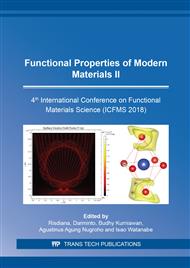p.126
p.133
p.139
p.145
p.151
p.157
p.163
p.169
p.175
Study on Formalization of Oil Palm Trunk Modified by Melamine Formaldehyde
Abstract:
The structure, composition and water content of a oil palm wood influence its dynamic mechanical properties. These are very important to study in relation to wood applications. The quality of oil palm wood can be improved through formalization treatment in acid and alkaline conditions and then impregnated by melamine formaldehyde. Variation of formalization time and curing temperature after impregnation on specimens were investigated. Based on physical properties and FTIR characterizations, the formalization time of both acidic and alkaline conditions with the melamine formaldehyde impregnation treatment, showed improving in physical properties of the samples after treatment and this is also indicated with a shift in wave numbers and emergenced a new functional group on FTIR spectra of the samples. The curing temperature has also led to increase density and decrease water content of the specimen, so therefore revealing a decrease of the hygroscopicity of wood.
Info:
Periodical:
Pages:
151-156
Citation:
Online since:
August 2019
Authors:
Keywords:
Price:
Сopyright:
© 2019 Trans Tech Publications Ltd. All Rights Reserved
Share:
Citation:


